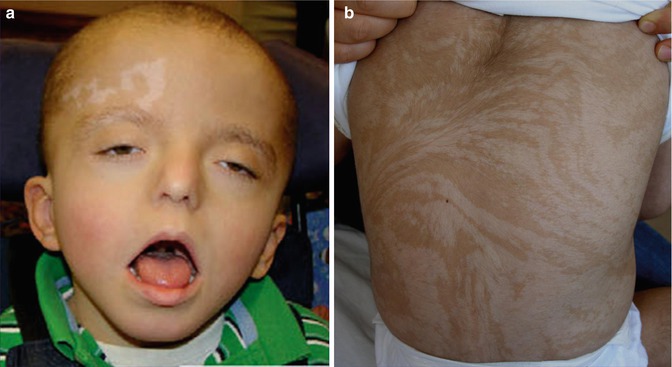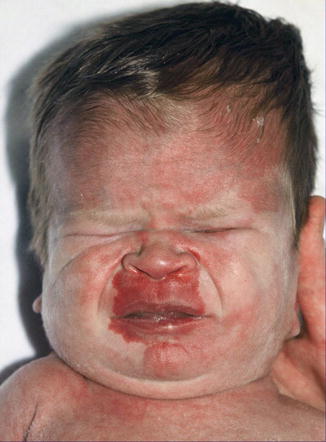(1)
Department of Dermatology, Freiburg University Medical Center, Freiburg, Germany
Abstract
The mosaic pattern of hypopigmention as noted in the Pallister-Killian syndrome is so far less well established, although a comprehensive iconography of such lesions was recently published by Wilkens et al. (2012). The asymmetric arrangement of achromic lesions does not appear to be compatible with Blaschko’s lines. In part, however, the distribution is reminiscent of “atypical” Blaschko lines. – Children with macrocephaly-livedo reticularis congenita syndrome (“macrocephaly-capillary malformation syndrome”) often show a peculiar port-wine stain being localized in the median area of the face. It is possible, but so far uncertain, that this unusual “mesotropic facial pattern” reflects mosaicism.
The list of different mosaic patterns as noted in human skin will probably increase in the years to come. In a girl with neurological abnormalities including mental deficiency and epileptic seizures, Ruggieri et al. [10] described cutis tricolor in the form of diffuse hypopigmentation of the trunk leaving a small area of normal skin on the left lateral aspect of the thorax and a segmental hyperpigmentation involving both arms and the trunk, apparently with a midline separation. It is so far unclear whether this arrangement represents a further distinct pattern of pigmentary mosaicism.
6.1 The Pallister-Killian Pattern
Children with Pallister-Killian syndrome, a sporadic phenotype reflecting mosaic tetrasomy 12p (isochromosome 12p syndrome), tend to display streaks and spots of hypopigmentation. In part, these macules are not compatible with the pattern of Blaschko’s lines (Fig. 6.1a), whereas other lesions appear to correspond to “atypical” Blaschko lines (Fig. 6.1b) [2, 5, 11–13]. Hyperpigmented macules have also been reported [3, 11]. A comprehensive iconography of the pigmentary anomalies of Pallister-Killian syndrome was published by Wilkens et al. [13].


Fig. 6.1
Mosaic hypopigmentation in Pallister-Killian syndrome. (a) A facial pattern being incompatible with Blaschko’s lines; (b) “atypical” Blaschko lines showing a pronounced deviation from the midline (a: Reprinted with permission from John Wiley and Sons, USA; b: Courtesy of Dr. Hülya Kayserili, Istanbul, Turkey)
6.2 The Mesotropic Facial Pattern
A mesotropic port-wine patch involving the median area of the face is a characteristic feature of macrocephaly-livedo reticularis congenita syndrome (“macrocephaly-capillary malformation”) (Fig. 6.2) (see Sect. 7.4.1.5). This pattern has been documented in numerous cases [1, 6–8] and can thus be taken as well defined, but it is so far uncertain whether this capillary malformation reflects mosaicism. One might argue that the spectrum of all other lesions of “macrocephaly-capillary malformation,” including livedo reticularis congenita, can best be explained by the action of a lethal mutation surviving by mosaicism [4, 9], but it seems prudent to wait for additional molecular data until the striking affinity of this particular port-wine patch to the median area of the face can be taken as a new mosaic pattern. In other words, until now we cannot be sure that this unusual skin lesion represents a nevus (see Chap. 7).









